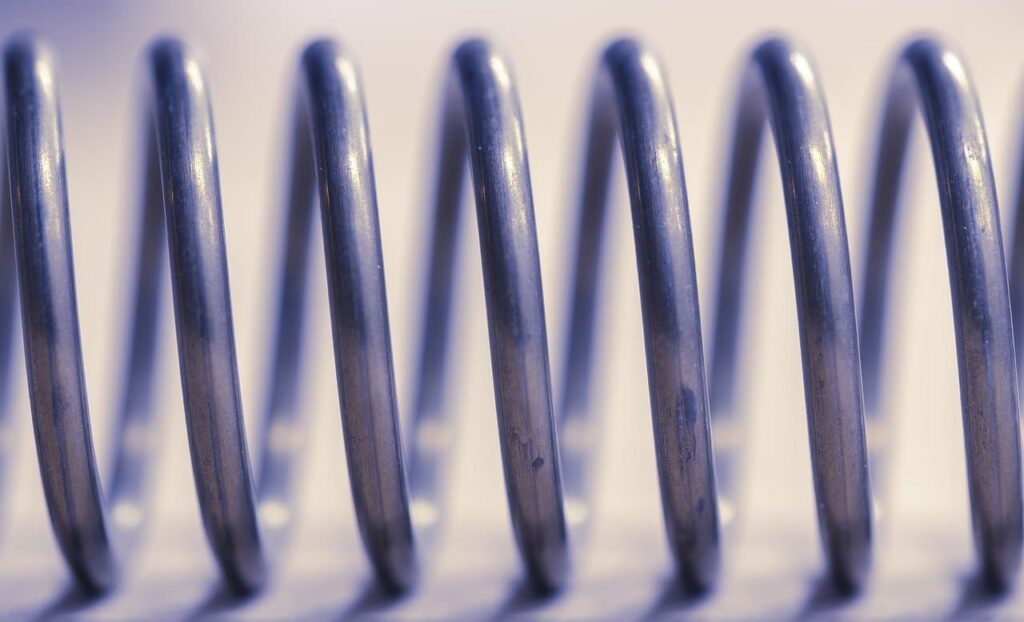
We call elastic materials the materials endowed with the ability to recover their original dimensions, once the sustained mechanical force that made them acquire a different shape ceases. For example: nylon, latex, rubber, polyester. This behavior is governed by Hooke’s Law, which understands the relationship between stress and strain under a Modulus of Elasticity.
Elastic materials can be natural, semi-synthetic or synthetic, depending on their degree of elaboration through the hand of man.
Examples of elastic materials
- Elastin It is a protein that gives elasticity and resistance to animal connective tissue, allowing it to expand and regain its shape.
- Rubber. It is a polymer of natural origin that is obtained from the sap of certain specific trees, it is water repellent, resistant to electricity, and highly elastic. It is used for many commercial applications, from toys to elastic bands.
- Nylon. It is an artificial polymer, derived from petroleum, belonging to the group of polyamides. Its elasticity is medium, depending on the additions during its manufacture.
- Lycra. Known as elastane or spandex, is a synthetic fiber endowed with enormous resistance and elasticity, which makes it ideal for textile and industrial applications.
- Latex. It is the most elastic material, different in its chemical composition from rubber and other vegetable gums of similar origin. Latex is made up of gummy fats, waxes and resins, extracted and processed from certain angiosperm plants and certain fungi. It is used a lot for gloves and condoms.
- Rubber. It is a resinous substance of very high molecular weight, whose acidic and solid character does not prevent it from having an enormous elasticity. It is one of the best known electrical insulators,
- Gum. It is a polymer of natural origin, the material used to make chewing gum is the sap of the tree Manilkara zapota(sapota or zapotilla), originally from the American continent. This resin is used not only in chewing gum, but also in varnishes, plastics and adhesives and, together with rubber, as an industrial insulator.
- Elastic band. Known as rubber band or rubber band, it is a rubber and rubber band, manufactured in a circular band and provided with hydrocarbons that reduce its elasticity in exchange for hardness and adherence. It is a good insulator, but very little heat resistant.
- Wool. It is a natural fiber obtained from mammals of the goat family, such as goats, sheep and camelids (alpacas, llamas, vicuñas) and even rabbits, through the shearing of the animal. With it, an elastic and fire-retardant fabric is made, useful for clothes to protect from the cold.
- Cartilage. Present in the human body and other vertebrates, it occupies the space between the bones and forms the auditory pinna and the nose. In some species it constitutes their complete or almost complete skeleton. It is elastic and lacks blood vessels, hence it can fulfill its role as a reducer of bone impact and a preventive of friction wear.
- Graphene It is a natural elastic, made up of a single layer of graphite, highly conductive and barely one atom thick. It is used enormously in electronics and nanotechnology, since it is a great conductor.
- Silicone. This inorganic polymer is obtained through polysiloxane, a liquid resin and is made up of silicon and oxygen atoms in an alternating series. It is odorless, colorless and inert even at high temperatures. Its industrial applications are very varied, even in the medical and surgical industry, or in the culinary one.
- Foam. Polyurethane foam (PU foam) is a form of porous plastic that does not exist in nature, but has huge industrial and commercial applications for man. It has an origin similar to that of polyester.
- Polyester. This is the name of an entire category of elastic substances discovered in nature since 1830, but artificially cultivated from petroleum. It is widely used in various industries due to its high resistance to humidity, chemical agents and mechanical forces.
- Neuromuscular bandage. Known as kinesiotaping, is a material consisting of various cotton tapes provided with an acrylic adhesive, capable of stretching more than 100% of its original size and used in the dressing of wounds and injuries.
- Balloons Made from flexible material based on rubber or aluminized plastic, they are flexible containers that are usually filled with air, helium or water and are used for recreational purposes. There is also a variety intended for medical and laboratory uses.
- Strings Made of flexible material arranged in a homogeneous strip, the tensioned strings can vibrate freely and reproduce acoustic waves. That is why they are used in musical instruments such as the guitar or the violin.
- Fiberglass. Obtained by stretching molten glass, it is a material composed of various polymers based on silicon, which give it flexibility. It is widely used as an insulator and conductor, especially in the telecommunications industry.
- Plastic. It is a huge set of synthetic materials obtained by polymerizing carbon derived from different hydrocarbons, such as oil. It is endowed with a certain elasticity and flexibility in the face of heat, making it possible to mold it into various shapes. Once cold, the elasticity margin decreases.
- Jelly. It is a semi-solid mixture (at least at room temperature) that is known as a colloid gel and is produced from the boiling of different animal collagens, such as cartilage. It is elastic and reactive to heat: they are diluted in hot water and solidify in cold.
